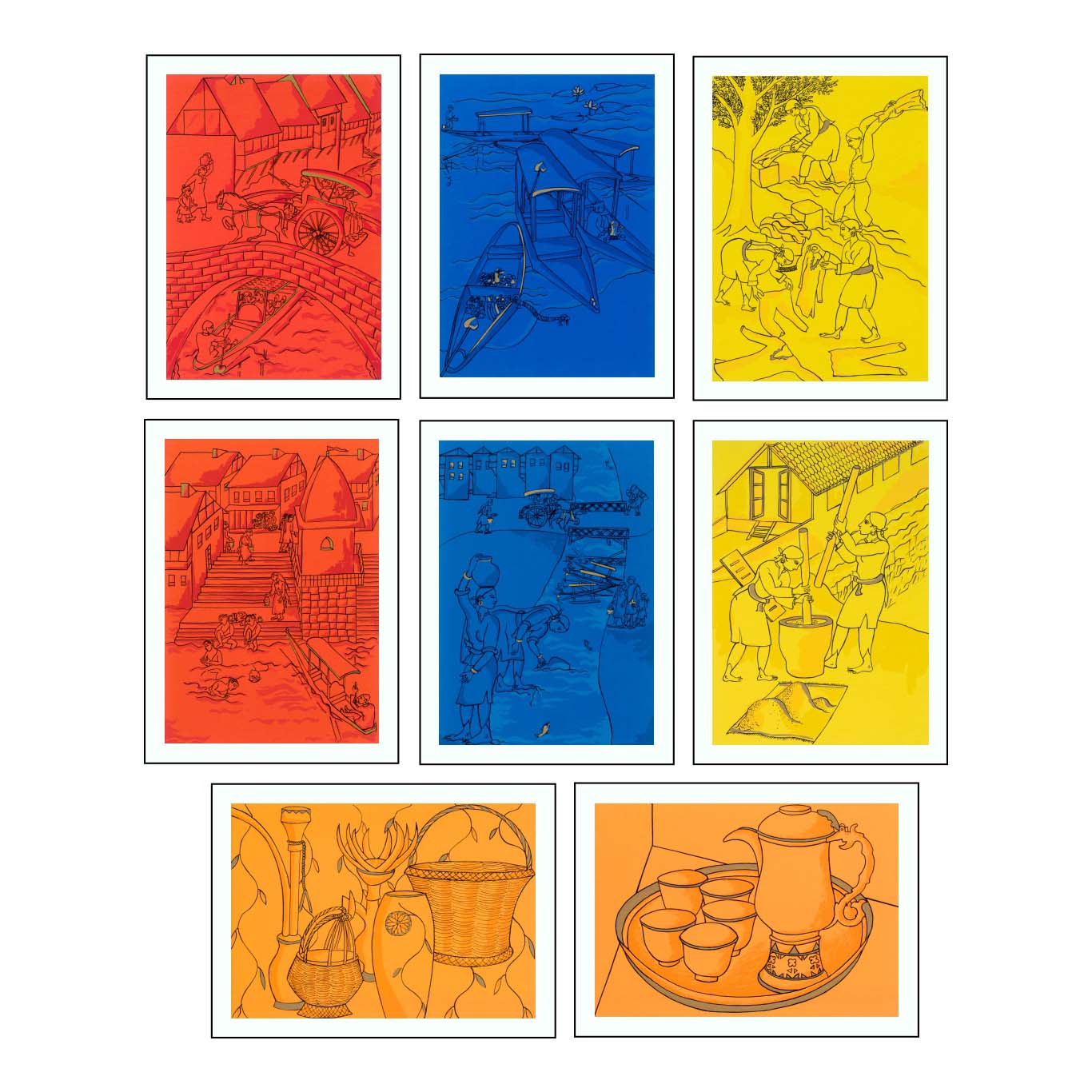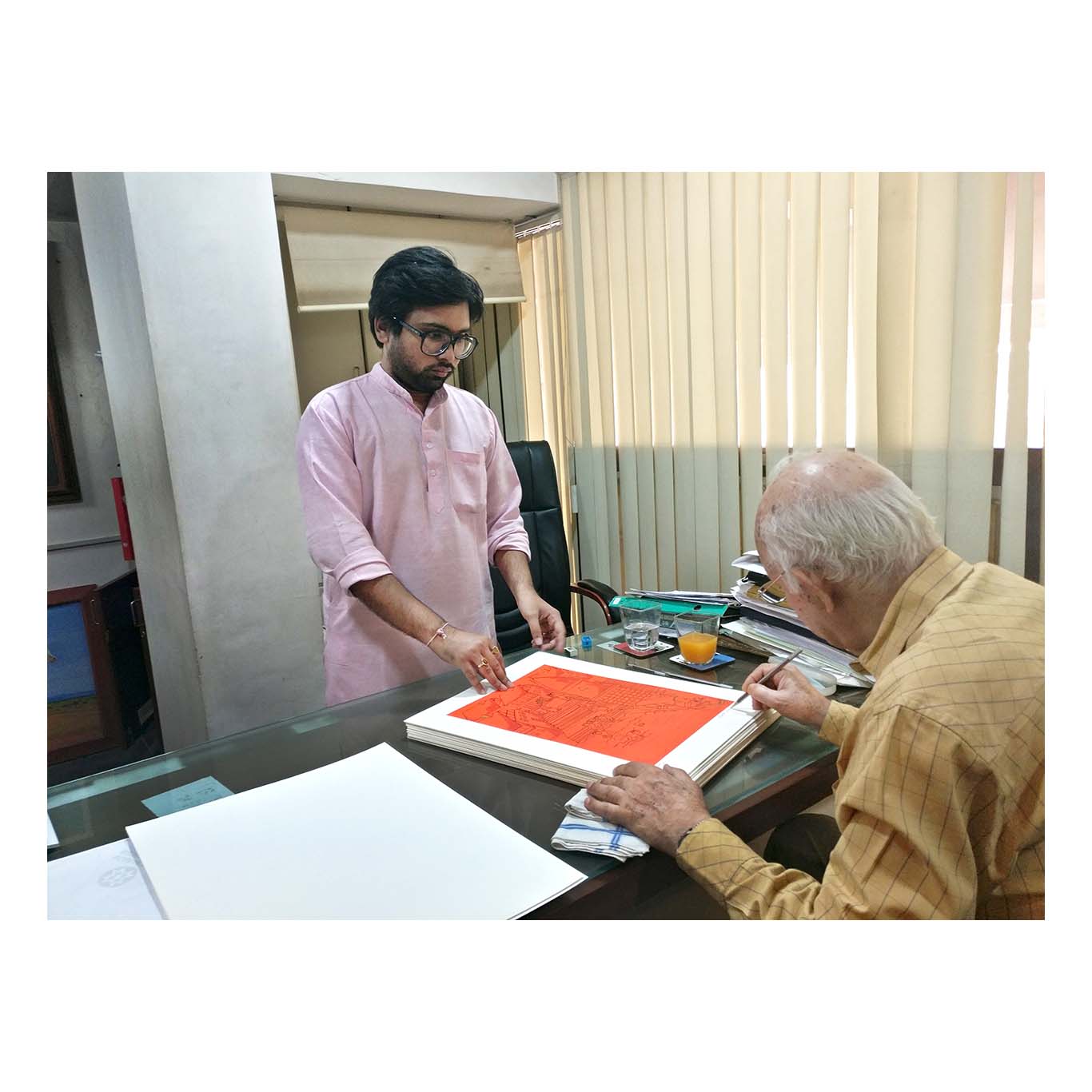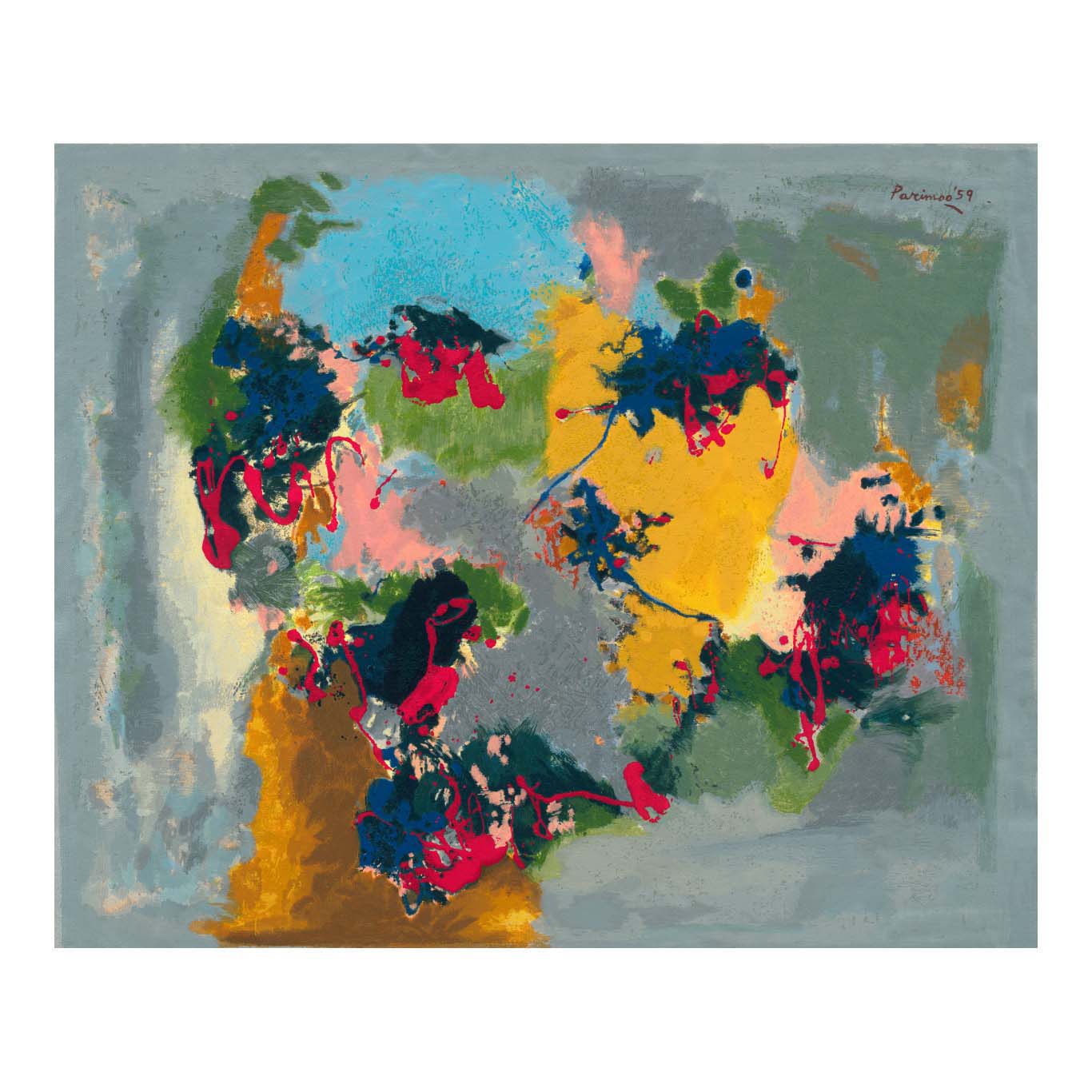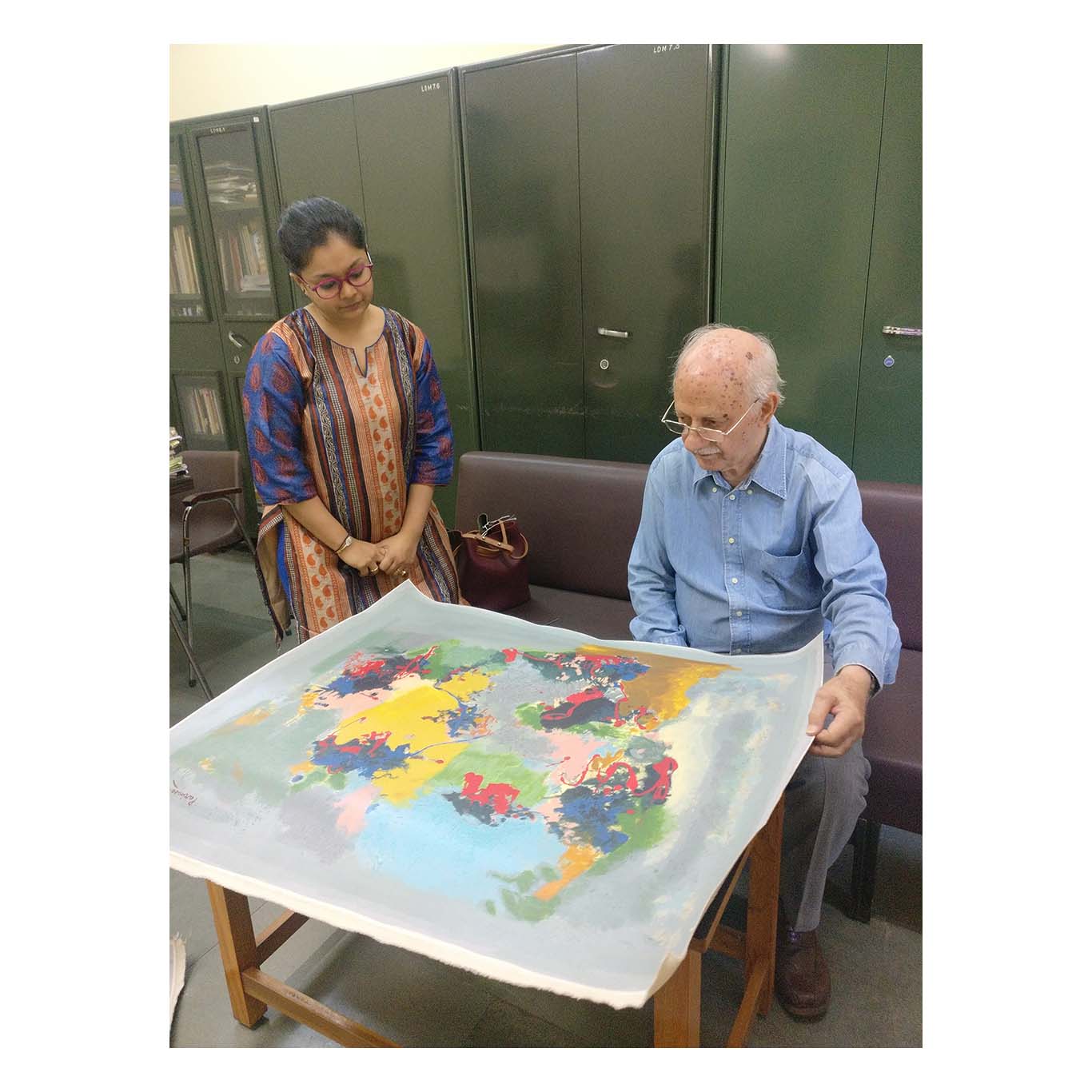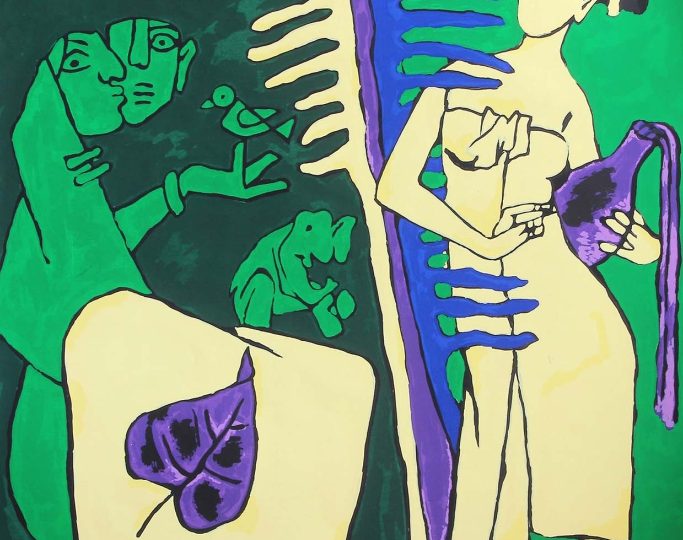This original artwork by Parimoo, a member of the first Baroda group of painters, was created in 1958. The artist expressed surprise at seeing a cot placed upside down, with its legs in the air, while a little boy was trapped in the middle, being teased by his siblings. At that time, he was particularly fascinated by depicting children.
Parimoo, recognized as one of the most significant figures in Indian modern art, adopted a sensitive approach to his work. The consistent guidance of Bendre Saheb inspired him to explore the use of calligraphic lines. He found the precision and fluency of these lines particularly compelling in Jain miniature paintings, where they are prominent and serve a purpose beyond mere decoration.
In notes accompanying many of his paintings, Parimoo elaborated on how his compositions were grounded in the principles of two-dimensional language, which he observed in Jain art. Reflecting on the nature of lines, he shared an intriguing perspective: when a dot begins to move, it transforms into a line, and when that line takes shape, it becomes a form.
When it came to color, Parimoo relied on his intuition and the shades of objects around him. He drew inspiration from the Fauvist movement, aiming to convey emotions through the interplay of colors. Jain miniature paintings and the vibrant costumes of rural women also significantly influenced his color application. In terms of composition, he was eager to translate the experiences from his daily life into a visual language that encompassed line, shape, color, volume, and space on the flat surfaces of various mediums. A couple of works by Parimoo, each over 60 years old, recently went up for auction at Christie’s, fetching commendable prices. Parimoo’s artwork evokes a sense of vatsalya rasa, reflecting the warmth and playful innocence of childhood.
These pop editions, titled Nagarnama, which means “Accounts of the City,” consist of a set of eight limited editions. Being a Kashmiri Hindu, Parimoo feels a deep emotional connection to Kashmir, his motherland. He reflects, “Kashmir holds for me the memories of bliss and care showered upon me by my family, friends, and this heavenly land. These memories have always captivated me, and I wanted to capture them permanently so they could endure through time.”
This series is particularly significant in the context of nostalgia, depicting the mohallas of Srinagar, where he spent his childhood wandering around the notable Habba Kadal bridge on the Jhelum River. His representation draws from memories of the 1940s, when children often visited the nearest river ghat for bathing and swimming. While tongas were one means of transport, shikaras (boats) also served as a mode of transportation along the river (known as Vitasta in Sanskrit and Vyath in Kashmiri). The houses lining the banks of the Jhelum exemplify remarkable “riverfront architecture.”
Parimoo explains that his compositions are based on the principles of two-dimensional language, which he observed in Jain paintings. He was also inspired by the Fauvist movement, striving to convey emotions through vibrant color play. The pop colors used in these serigraphs keep the work lively and modern, creating a contemporary aesthetic. Parimoo’s collection evokes a profound sense of shanta rasa, embodying tranquility and the serene beauty of nostalgia.
Ratan Parimoo, one of the pioneers of Abstract Expressionism in India, was born in 1936 in the picturesque city of Srinagar, Kashmir. He is a prominent modern Indian painter. At just 15 years old, he moved to Baroda in 1951 to pursue his passion for fine arts and explore the rich landscape of Indian art. Under the mentorship of the esteemed painter N.S. Bendre, Parimoo earned both his bachelor’s and master’s degrees in fine arts from the Maharaja Sayajirao University in Baroda. In 1960, he relocated to London on a Commonwealth Scholarship, where he obtained a B.A. Hons in the History of Art from London University. Driven by his fascination with fine arts, he later pursued and achieved a PhD in art history.
Parimoo’s work has been showcased in retrospective exhibitions in New Delhi (1972 and 2006) and Mumbai (1999), and his art regularly features in auction houses worldwide. His pieces are held in numerous prestigious private and public collections globally.
At Drs Editions, we recognize the importance of documenting works that possess ‘legacy’ value. This collection showcases pure abstraction and features an abstract expressionist work created by Parimoo in the 1950s, a time when most artists were focused on figurative art. Alongside his peers and mentor, he ventured into uncharted territory for Indian art. This edition marks our first serigraph on canvas at this scale, presenting a limited edition intended for future generations.
Parimoo approaches his art as a conductor of a symphony of colors and expressions. The viewers can also imagine themselves as conductors in an opera theater, striving to convey meaning through color, brush strokes, and composition to enjoy this work. Like a musician, Parimoo arranges forms, colors, textures, and brush strokes to express ideas, emotions, and thoughts. Each color conveys emotion; brush strokes reveal intensity, while textures and lines enhance the overall composition. Spontaneity plays a vital role, adding a background rhythm that supports the entire piece. The embossed effect, achieved through multiple screens of the same color, ensures that each stroke retains raw emotion and expression, contributing to the work’s aesthetic appeal. This piece signifies qualities of wildness, impulsiveness, and immediacy, inspiring us to innovate fearlessly.
This edition utilized 95 screens and took 60 days to complete 125 editions. It has garnered multiple awards, including accolades from Printweek India, Screen Print India, and the prestigious National Award in 2018.
Ratan Parimoo’s serigraph ‘The Conductor’ evokes Adbhuta Rasa, providing an experience of abstract expression through its vibrant colors and dynamic composition.
Photos and Text © Chaitya Dhanvi Shah
printing, distribution or copying of this text/images without permission is not allowed.
Photos and Text © Chaitya Dhanvi Shah
printing, distribution or copying of this text/images without permission is not allowed.



